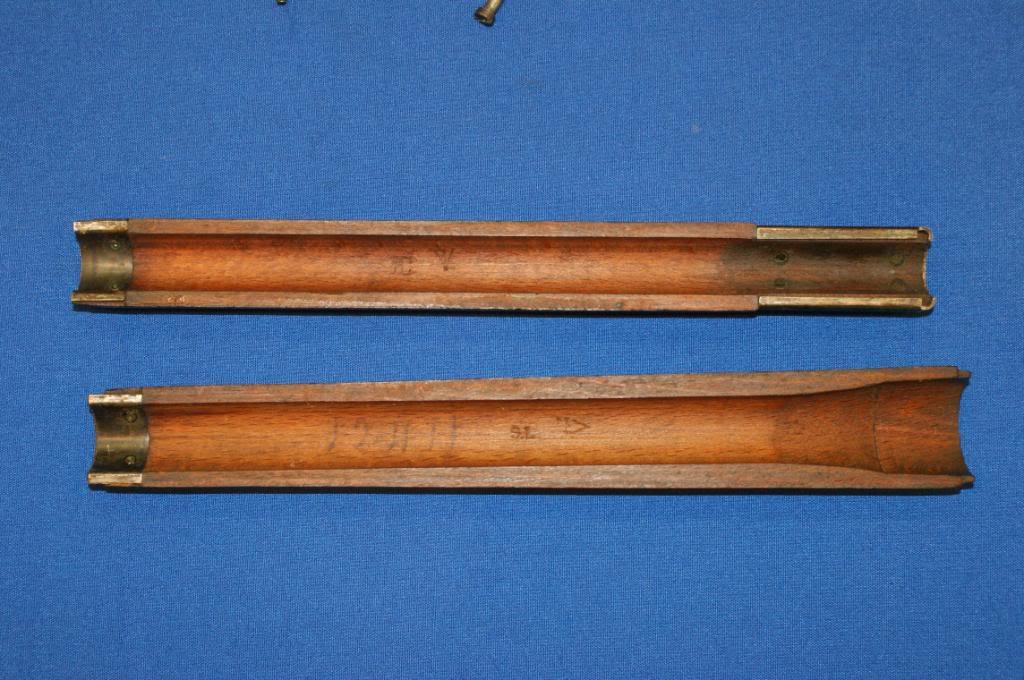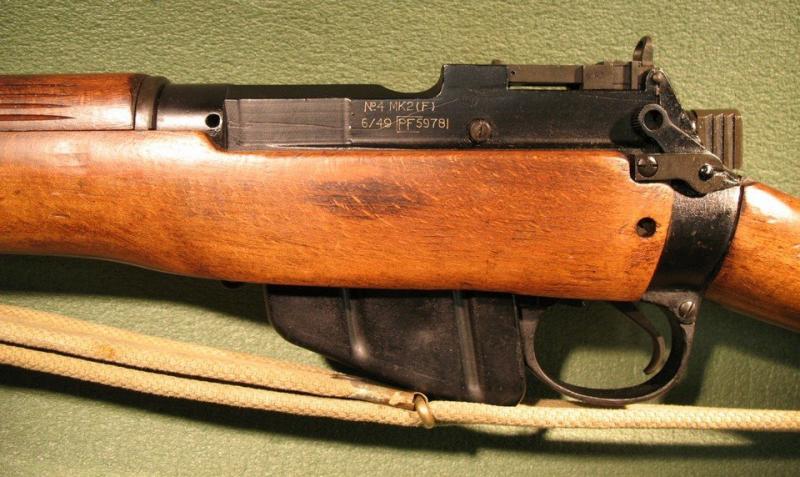-
FREE MEMBER
NO Posting or PM's Allowed

Grooved hand guards
I know one of you experts can answer this without directing me to some reference book that I don't have:
Which model No. 4s had grooved upper handguards, what exactly was their purpose and why were they discontinued and/or not universal on all No. 4s?
Keith
Information
 |
Warning: This is a relatively older thread
This discussion is older than 360 days. Some information contained in it may no longer be current. |
|
-
11-18-2013 07:39 PM
# ADS
Friends and Sponsors

-
Legacy Member

My understanding is grooved = early. Some had some had not. Not particular to a model. Different makers. Different processes. I am new though and young. 
-
-
-
FREE MEMBER
NO Posting or PM's Allowed


Originally Posted by
cprher

grooved upper handguards
It does seem like it was most common on early rifles, and the practice seemingly erased on the No.4 Mk2. While it seems like the grooved handguards were common to earlier production rifles (which is true), every BSA-Shirley produced (m 47 coded) I've ever seen was built similarly to the earlier standard: grooved handguards and rear sight that is adjusted by the screw knob on top.
-
But even BSA rifles can be found with smooth rear handguards. I've never seen a definiive answer. And given the ease of replacement for a relatively fragile (It must be Italian ) part, the question may never be answered by observing existing specimens. The grooves don't seem to serve any purpose, but they look good. Gotta be stylin' whilst in the field...
) part, the question may never be answered by observing existing specimens. The grooves don't seem to serve any purpose, but they look good. Gotta be stylin' whilst in the field...

Best hope barring the unearthing of process change documentation? Look for serial numbered handguards on No.4 Mk.I(T) rifles that don't appear to have seen much service before being surplused, like these off a 1941 Maltby "(T)". But the sample size is probably too small be definitive.
Last edited by jmoore; 11-19-2013 at 03:17 AM.
-
Thank You to jmoore For This Useful Post:
-
Advisory Panel


Grooved handguards can be found as original fitments on Mk2s built in the 1950s. There is no definitive pattern to their use.

-
Thank You to Thunderbox For This Useful Post:
-
Grooved handguards were authorised to be discontinued by the committee for the simplification of small-arms production in 1941. They allowed zillions of small simplification processes. HOWEVER, where 'simplification' was not that simple for the manufacturer, for example, where he used that part to preceed onto the next part of the process (like the flutes on the Mk1 Bren gun gas cylinder which would cause production problems if deleted earlier.....), and it didn't lengthed the production process, the old method stayed stayed.
So some continued with the flutes while others deleted them and others simplt commenced production without. It's really that simple. It was also called 'relaxation in standards. But that was something else too......
There, another useless bit of Enfield production history that I learned from the Sten Gun saga
-
The Following 4 Members Say Thank You to Peter Laidler For This Useful Post:
-
So some continued with the flutes while others deleted them and others simplt commenced production without.
So the next investigation would require looking into each of the subcontractors! Not much chance of getting the complete story from each at this late date, I reckon.
The real question is why would it matter? It's not something one would want to grasp firmly whilst shooting. Nor does it seem to help maintain control during the odd drive-by bayoneting.
-
-
Deceased January 15th, 2016

Like the lack of a proper pistol grip, but a rather straight small of the butt instead on Lee-Enfields, they were for bayonet fighting.
Using a rifle for a hanging a bayonet on was an obsession with the British Military establishment in spite of all the evidence in the Great War (and earlier - Omdurman for example) that the number of enemy causalities caused by "the cold steel" was minuscule.
Military establishment in spite of all the evidence in the Great War (and earlier - Omdurman for example) that the number of enemy causalities caused by "the cold steel" was minuscule.
"Bayonet fighting" was largely a myth and the bayonet only used as a last resort. There is little doubt that "fixing bayonets" gets one into the right frame of mind but it should not have been used to downgrade the shooting efficiency of the rifle, as it was with the Lee-Enfield.
The SLR had a proper pistol grip but it could still be used with a bayonet. Probably not a efficiently as a Lee-Enfield but then, like the Lee-Enfield before it, the SLR was mostly used for its proper job of chucking large amounts of lead at the enemy.
Last edited by Beerhunter; 11-19-2013 at 05:48 AM.
-
The same committee for the simplification of small arms also instigated another sub committee that looked into applications for small sub contractors to relax the specified standards. This allowed a contractor who had stocks of, say, a slightly thinner/thicker or lower/higher spec material or better fabrication facilities - you know the sort of thing- the Band, lower was a good example, to 'utilise and make best use of his existing stocks and existing facilities in the interest of expediency.....' I think the wording went. So thinks might look a little different in some ways, but were acceptable. Sten gun producers were masters of this art! The problem there was that on their own, these little changes were of no significance and were permitted quite easily and speedily. But when conjoined with, say other relaxed standards parts, caused problems, albeit sometimes minor.
-
-
FREE MEMBER
NO Posting or PM's Allowed

'utilise and make best use of his existing stocks and existing facilities in the interest of expediency.....'
This, I think, was correct for ALL arms companies involved in war production, Allied or Axis. A good example of the same thing being the German 98k: it experienced MANY very obvious changes during its career, yet examples produced on dates from 1939 onward might be built as a mixture of new and old style parts. A good example being a 1943 rifle: it could have either two types of milled front band, or one style of stamped...one type of milled or stamped rear band...either laminate or solid hardwood stock, with either a solid milled or stamped butt-plate....the list and possibilities goes on and on.
98k: it experienced MANY very obvious changes during its career, yet examples produced on dates from 1939 onward might be built as a mixture of new and old style parts. A good example being a 1943 rifle: it could have either two types of milled front band, or one style of stamped...one type of milled or stamped rear band...either laminate or solid hardwood stock, with either a solid milled or stamped butt-plate....the list and possibilities goes on and on.
The point I'm making is that although official changes in production and specifications for parts happen, it is not always immediately: a company is wise to use its old stock of parts in inventory first, whilst tooling up to produce new-style parts. Sometimes this can take quite a while, and sometimes old-stock trickles on seemingly forever. It's really random, haphazard, and fundamentally somewhat unpredictable.















 Register To Reply
Register To Reply















